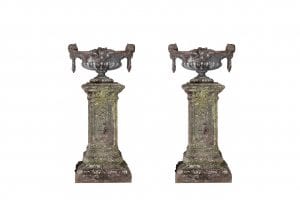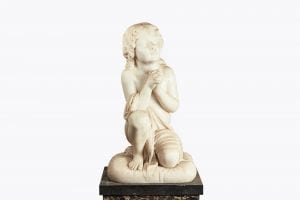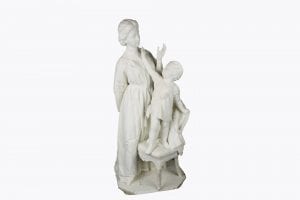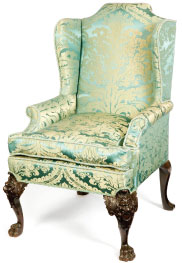Extremely rare and very fine statuary has been created in many cultures from prehistoric times representing various important figural and animalier representations of notable personalities, heroes, animals and Gods, both real and mythical. The first garden statues most presumably were portraits to worship various Gods. However, it was soon realised that statuary could also be used as beautiful ornamental pieces for both gardens and interior spaces. The conquest of Greece by Rome in the Battle of Corinth in 146 BC ensued in Greek statues being appropriated and utilised to decorate the gardens and palaces in Rome, inspiring a decorative fashion that would spread across Europe and the rest of the world for many centuries and be highly desirable and sought after in our contemporary modern times.
The image above depicts the collection of a late 19th Century set of four baroque style cast stone putti, each figure modelled playing a different instrument; flute, lute, and tambourine. One sole Putti represents Cupid holding his bow and arrow aloft. The collection of Putti are variously posed, seated on a sphere surmounting a socle and raised above a separate plinth of ogee profile decorated with lion’s head ring handles. I have also included some other rare and striking statuary for you to view.

An early 19th Century Neoclassical pair of cast iron twin handled garden urns with foliate and gadroon motif supported on outscrolling socle raised on plinths of square form with decorative motifs in low relief.

A 19th Century stone bust of Ares God of War (known in Roman mythology as Mars), after The Ares Borghese. As the son of Zeus and Hera he is one of the Twelve Olympians.
His head slightly turned to his right, wearing an attic helmet decorated with animals and mythical beasts. Upon the helmet sits a sphinx supporting the plumage.
From the almost identical facial structure and features this sculpture is known to be a rework of the Ares Borghese, a Greek original by Alkamenes circa 420 BC. The original’s decorative helmet is now missing, but this sculpture serves to give an idea of how the Ares Borghese would have looked.
The Ares Borghese is a Roman marble statue of the imperial era (1st or 2nd century AD). It is 2.11m high. It is identifiable as Ares by the helmet and by the ankle ring given to him by his lover Aphrodite. The cult and representation of Ares are very rare in the ancient Greek world, especially in sculpture. It has been thought that this statue may be derived from one by Alcamenes, an Athenian sculptor who, according to Pausanias (I, 8, 4), made a statue of Ares that was erected on the Athenian agora.
Formerly part of the Borghese collection, it was purchased from there in 1807 by Napoleon.

An incredibly rare and fine 18th Century Italian statuary white marble figural sculpture of kneeling child.

An early 19th Century figural marble sculpture of mother and child. Exquisite carving depicts the child standing on a Chippendale style chair draped with military uniform tenderly reaching for his mothers face.
Please browse through our website to see some other fine samples of antiques in both our Dublin and New York Galleries.

